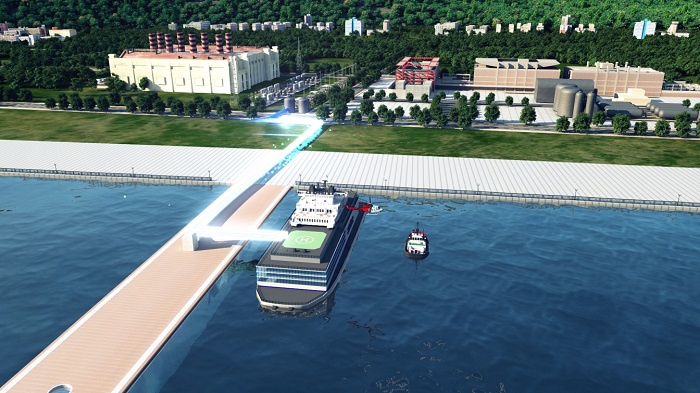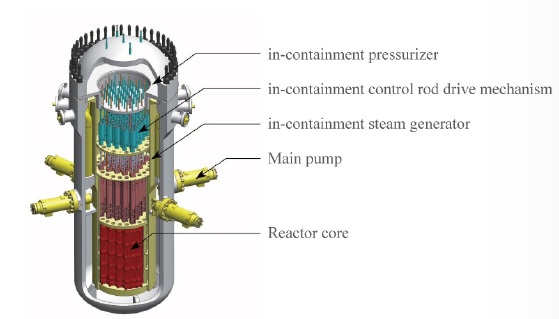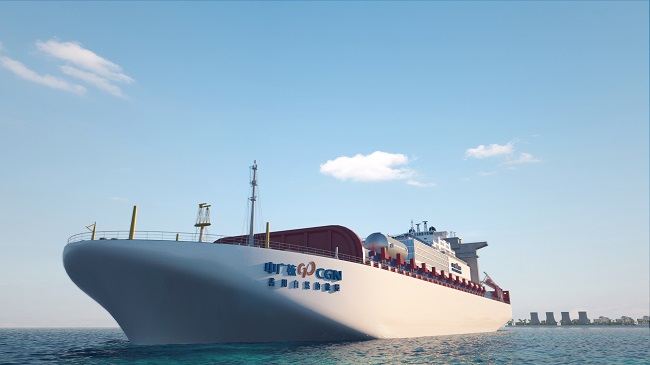However, it was also announced that China National Nuclear Corporation (CNNC) had signed an agreement with CSIC to develop floating nuclear power plants (the agreement was signed on January 20).
What all of this means is that CGN now has two shipyard outlets that will allow for development and production of floating nuclear plants, while CNNC has newly entered the field with just one of the two. These developments are a strong hint that the Chinese government intends fairly soon to construct far more than one floating plant prototype.

CGN floating nuclear power plant connected to shore facilities. Courtesy CGN
Uses for the plants shown in the limited literature available include power for offshore oil rigs and power for more remote onshore areas. It has also been stated by CGN itself that these are also intended for use in the South China Sea, where China has been augmenting and constructing islands, which appear at least partly to have a military purpose. The plants may be set up to provide fresh water as well as electricity. According to official reporting, the Chinese may want as many as 20 of these floating plants. Bringing in a second reactor supplier and a second shipyard (beyond the established duo of CGN and CSIC which together are contracted to build the first) is a sign that this estimate isn't wholly unrealistic.
CGN achieved a milestone in 2015 when its ACPR50S small modular reactor was approved to take part in the 13th Five Year Plan, meaning it is approved for detailed design and construction. According to CGN's website, the initial prototype floating plant is intended to be complete in 2020.
CNNC, on the other hand, appears to lag well behind on reactor development. Although now missing from the company's site, the ACP100 SMR (designed for 385 MWt/120 MWe per module when built for a land power plant) was at one time somewhat heavily pushed; it remains to be seen if this design, or some other, will form the basis for CNNC's design effort.
The two designers' plans for their SMRs differ considerably. CNNC has adopted the iPWR or integral pressurized water reactor approach, wherein the reactor core and steam generators are all contained within the pressure vessel. Meanwhile, CGN's design has a separate reactor vessel, two steam generators, two main coolant pumps, and a pressurizer, all of which are extremely compact and closely mounted. Only the CGN design has been advanced sufficiently to determine qualities of the overall nuclear power plant barge. It will feature the nuclear steam supply system being located below the waterline, and sufficient onboard facilities so as to require no external response or assistance in case of any troubles on board.

CNNC's ACP100 design followed the classic iPWR pattern, and has pumps mounted radially not unlike the KAERI "SMART" SMR. Courtesy CNNC
For now, at least, only the opening moves have been made in what looks to be the start of a big thing. Given the established approval of CGN's SMR design process, it seems certain that one or both shipyards will construct floating plants with the ACPR50S. Whether the CNNC design (whatever that may be) gets into the fray we do not yet know, but the shipyard agreement is one sign that the established ACPR50S may have some competition.
• • • • • •
 Will Davis is Communications Director and board member for the N/S Savannah Association, Inc. He is a consultant to the Global America Business Institute, a contributing author for Fuel Cycle Week, and he writes his own popular blog Atomic Power Review. Davis is also a consultant and writer for the American Nuclear Society, and serves on the ANS Communications Committee and on the Book Publishing Committee. He is a former U.S. Navy reactor operator and served on SSBN-641, USS Simon Bolivar.
Will Davis is Communications Director and board member for the N/S Savannah Association, Inc. He is a consultant to the Global America Business Institute, a contributing author for Fuel Cycle Week, and he writes his own popular blog Atomic Power Review. Davis is also a consultant and writer for the American Nuclear Society, and serves on the ANS Communications Committee and on the Book Publishing Committee. He is a former U.S. Navy reactor operator and served on SSBN-641, USS Simon Bolivar.





 Will Davis is Communications Director and board member for the N/S Savannah Association, Inc. He is a consultant to the Global America Business Institute, a contributing author for Fuel Cycle Week, and he writes his own popular blog Atomic Power Review. Davis is also a consultant and writer for the American Nuclear Society, and serves on the ANS Communications Committee and on the Book Publishing Committee. He is a former U.S. Navy reactor operator and served on SSBN-641, USS Simon Bolivar.
Will Davis is Communications Director and board member for the N/S Savannah Association, Inc. He is a consultant to the Global America Business Institute, a contributing author for Fuel Cycle Week, and he writes his own popular blog Atomic Power Review. Davis is also a consultant and writer for the American Nuclear Society, and serves on the ANS Communications Committee and on the Book Publishing Committee. He is a former U.S. Navy reactor operator and served on SSBN-641, USS Simon Bolivar.